First Aid Kit:
Introduction:
First aid kits are a legal requirement for every workplace. It must also be clearly marked in a green box with a white cross on it. Your staff should all be made aware of where their nearest first aid box is located; it should be easily accessible for people and the contents should be checked regularly to make sure all items are in stock and in date.
Keep a first aid kit readily available in your home, cottage, car, boat, workplace, and recreation area. Store it in a dry place and replace used or outdated contents regularly.
The Health and Safety (First-Aid) Regulations 1981 require you to provide adequate and appropriate first-aid equipment, facilities and people so your employees can be given immediate help if they are injured or taken ill at work.
What is ‘adequate and appropriate’ will depend on the circumstances in your workplace and you should assess what your first-aid needs are.
The minimum first-aid provision on any work site is:
- a suitably stocked first-aid box
- an appointed person to take charge of first-aid arrangements
- information for employees about first-aid arrangements.
It is important to remember that accidents and illness can happen at any time. First aid provision needs to be available at all times people are at work.
There are so many options and so much that could be in a kit.
To find out which first aid kit is best for you start with the following questions:
- Where do you plan to use it?
- Is it for the car, home, boat, holiday or overseas travel?
- What will it be used for?
- What are the likely accidents or injuries that you may encounter?
Maybe the first aid kit is needed for a group activity.
- What activities will the group be doing? "Lazing" around listening to lectures or doing extreme sports?
Depending on what you are wanting the kit for and the amount of people it needs to cover, will influence the size of the kit and the type of container you store it in. A tackle box makes a good first aid kit container or it can be as simple as a resealable clip lock bag. Where you keep the kit will also influence its size. So where will you store the kit?
- bathroom cabinet
- kitchen cabinet
- car (if it is a small kit the glove compartment is most accessible)
- boat
- workshop
- garage
- backpack
Your First Aid Kit should always be kept in an area where it can be easily found and accessed.
Variety of first aid kit checklists: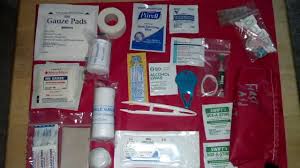
Basic First Aid Kit - A basic first aid kit doesn't need to include every piece of First Aid equipment though it might as well have basic yet useful content.
Motor Cycle First Aid Kit - A Motorcycle First Aid Kit has special needs. An ordinary first aid kit just won't cut it. They need a different balance of first aid content. Check out our Motorcycle First Aid Kit Checklist.
Marine First Aid Kit - If you get injured on a boat you may not be near help. You need to be able to treat yourself and your shipmates for any emergency that might arise. You will be set for almost any boating injury with this Marine First Aid Kit Checklist.
Wilderness First Aid Kit - We have put together a wilderness first aid kit checklist which is the minimum of what you should be taking with you. It will help you put together a first aid kit that will tackle many injuries and ailments that might come your way while in the wilds.
Backpacking First Aid Kit - When going backpacking taking a first aid kit is a must as you can't always find a doctor near by. It is vital to be prepared for emergencies. Check out our backpacking first aid kit checklist. Also there are questions for you to answer that will help narrow down what is crucial to pack in the first aid kit.
Hiking First Aid Kit - Never be complacent when packing for a hike and always carry a hiking first aid kit with you. The one time you don't will be the time you need it. We’ve created a list of some important safety items to consider when putting together your own hiking first aid kit.
Travel First Aid Kit - When traveling research your destination. Some areas may have dangerous or venomous wildlife while others are notorious for having polluted water that harbors nastiest such as giardia or the like. Be sure you know what to avoid and take what you need as a safety precaution. Checklist Coming Soon
Vehicle First Aid Kit - It makes sense to have a Vehicle First Aid Kit on hand for accidents you may come across while traveling on the road. You may need to deal with injuries ranging from bruises, cuts and scrapes, to moderate injuries, such as broken bones. Then there are the more serious, life-altering injuries like severe bleeding, or even an unconscious person where you may need to do CPR. Be prepared.
A few more important suggestions:
- Remember to always check medication expiry dates and replace outdated items in your kit.
- Store the kit out of the reach of little ones who might find it an interesting play thing to explore.
- Know how to use the items in the kit - Become familiar with a first aid manual you find easy to understand so that you will not be scrabbling to learn something from scratch but will be able to scan instructions to remind you what to do.
- Keep your first aid manual with the first aid kit at all times.
- If you have not done a First Aid Training Course, strongly recommends that you either do a course in your local area or online.
Basic first aid kit:
A basic first aid kit doesn't need to include every piece of First Aid equipment although it might as well have basic yet useful content.
So what do we suggest goes in a basic first aid kit?
- Basic first aid manual - one that is easy to understand. Sometimes it's hard to remember what to do in an emergency. A pocket-sized manual comes in handy, taking you step-by-step through first aid care. We think it is best to read through it so the layout and contents are familiar before you need it in the heat of the moment.
- Antiseptic wipes or gel - for cleaning your hands before touching open cuts and wounds.
- Gauze and non-adhesive dressing pads - preferably sterile. They come in all sizes. One option, if you are trying to save space, is to get a bigger size dressing that you can cut to size as needed. It will save space.
- Elastic and crepe bandages - a few different widths.
- Triangular Bandage - For slings, padding, strapping limbs to splints when fractures are suspected.
- Adhesive Tape - I prefer paper tape as you do not have to have scissors to cut it as it will tear by just using your fingers - Get a good quality tape that will not get brittle with age or lose it's stickiness. It is useless when that occurs.
- Curved Scissors - Scissors come in handy in many ways. Curved medical ones are great as they don't have sharp points. In an emergency you might need to cut clothes away from an injury. With sharp edges it is easy to poke through something and cause further injury when you are in a hurry or under stress.
- Two tongue depressors or ice block sticks for finger splints.
- Instant Cold Pack/s - These are so useful for burns, bruising, swelling and sprains. They are single use, so if you have space grab a couple for your kit.
- Band Aids - a variety of shapes and sizes for small cuts and scrapes. I find the long strips of cloth tape with the padding in place already is great because you can cut it to size.
- Tweezers - A good pair of tweezers has easy-to-grip handles and can be used for splinter removal and other first aid procedures. Do not bother with a poor quality pair that will not grip a splinter you are trying to pull out as you will just get frustrated.
- Pain Reliever Capsules or liquid (liquid is best for children who can not swallow tablets).
- Anti-histamine - tablets or liquid (again for those that can not swallow tablets).
- Stings and Bites Cream- I prefer one with a local anesthetic especially for the kids. My son scratches his bites when he is asleep and ends up with bleeding and weeping sores so knocking out the itchiness of bites before he goes to sleep reduces the scratching.
Other things to consider when putting together a basic first aid kit:
When an accident or injury occurs you may not have much time to read a manual while trying to give first aid to an injured person. We at First Aid anywhere recommend you do a First Aid Training Course to learn what first aid challenges you may encounter and how to treat them.
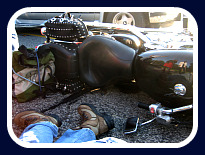
A Motorcycle First Aid Kit has special needs:
An ordinary first aid kit just won't cut it. This is mainly to do with size, but also the types of common injuries that bikers may experience need a different balance of first aid content.
Common injuries for motorcycle riders are:
- Burns - sunburn and heat burns, minor and less common major, from exhaust pipes and other sources.
- Eye injuries - things flying or blowing into the eyes.
- Cuts, Abrasions and scrapes - usually from hitting the road literally.
- Fractures.
When packing a Motorcycle First Aid Kit, or looking to buy one, consider kit contents that are used for stopping bleeding, treating burns, abrasions and cuts and eye injuries.
It is important to know the purpose of and how to use every item in your motorcycle first aid kit - otherwise it's just taking up space.
Motorcycle First Aid Kit Checklist:
- A good compact first aid book.
- Antiseptic Wipes - 5 or 6 packet wipes.
- Antibiotic Ointment or powder- Individual packets.
- Anti-microbial Hand Cleaner - Water less: They make water less hand cleaners in individual packets. Bring five or six. There are small bottles of Anti-microbial gel as well.
- Band-aids - A variety of shapes and sizes for small cuts and scrapes. We like to pack knuckle and fingertip band aids. They really work a treat and cling on well.
- Stern-strips (Butter-fly sutures, Adhesive Sutures, Adhesive Closures) - used to pull a small gaping cut or wound together.
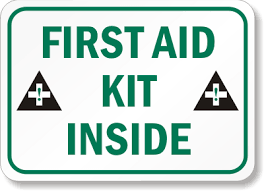
- Large Combine Pads - For heavy bleeding.
- 5 Large Sterile Gauze Pads - For bleeding. Most first aid kits do not have enough gauze or absorbent dressings to be useful in a motorcycle kit, so don't skimp on the dressings.
- 5 Medium Sterile Gauze - If you don't want to carry this smaller size carry extra of the larger size and cut them down to what you need.
- CPR Mask.
- Emergency Blanket - These are great for retaining body heat and can be used as a reflector for rain and ground cover.
- Normal saline 10ml vials - this doubles as an eye wash or wound cleansing.
- Instant Cold Pack/s - These are so useful with burns, bruising, swelling and sprains. They are single use so if you have space grab a couple for your kit.
- Burn cream or gel - Aloe Vera aids in healing, pain relief, has anti-inflammatory properties, helps prevent blistering and scarring.
- Glow Stick - High intensity emergency glow stick for directing traffic or signalling for help.
- Heavy Duty Zip-lock Bags - Tons of uses including removing used and contaminated gauze, gloves and dressings.
- Latex gloves - Bring a minimum of 4 pairs.
- Non-deodorant Feminine Pads - This is an old first aider trick. Feminine pads are highly absorbent and great for stopping heavy bleeding. Cut them in half for easy storage and usability.
- Other medication - Pack the travel size or sample packets not the bottles. These are usually small packets that contain 2 to 4 pills. Or put the pills in small zip-lock bags and label them carefully.
* Anti-diarrhoea tablets
* Anti-acid
* Antihistamine: for mild allergic reactions
* Pain reliever
- Triangular Bandage - For slings, padding, strapping limbs to splints when fractures are suspected.
- Trauma shears - Go for the heavy duty pair, a size 7 1/2. You'll need to be able to cut through leather. You won't have time to unzip and undress if there is heavy bleeding you'll need to cut through the leathers. I know, I know just take a deep breath and do it.
- Curved Scissors - Scissors come in handy in many ways. Curved medical ones are great as they don't have sharp points. In an emergency you might need to cut clothes away from an injury (not leathers this time "phew"). With sharp edges it is easy to poke through something and cause further injury when you are in a hurry or under stress.
- Elastic and crepe bandages - a few different widths. 10cm (2") and larger are often more versatile then smaller ones.
- Tweezers - A good pair of tweezers has easy-to-grip handles and can be used for splinter removal and other first aid procedures. Do not bother with a cheap quality pair that do not grip splinters as you will only get frustrated. I know I have.
- Mobile phone - most people own one these days but worth mentioning anyway.
Of course the big trick is getting all this stuff in a container small enough to actually fit on the motorcycle. Look for soft sided waterproof zipper cases. And believe it or not you should be able to get all this stuff in a bag about 20 x 13 x 8 cm (7" x 5" x 3").
It can be done!
Other things to consider when putting together a Motorcycle First Aid Kit:
Consider packing these items in separate strong zip-lock bags. The reason is you will need to stuff all these items into a small bag -as mentioned above- it is very useful to use one bag for each 'type' of item such as gauze in one bag, medication in another and medical tools (scissors and tweezers) in another. Then when you pull out the items from the main bag they do not all tumble out and end up in a mess on the ground. This will not instill confidence in the person you might be helping.
With this packing system not only is it easier to find what you are looking for it also gets you familiar with what is in your kit, what it's for and how to store it on your motorcycle.
Last thing, you may not have much time to read a manual while trying to give first aid to an injured person or yourself. We recommend you do a First Aid Training Course to learn what first aid challenges you may encounter and how to treat them.
Vehicle First Aid Kit :
on hand in case you are involved in or come across an accident. 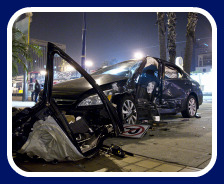
Car accident injuries range from... minor injuries, such as bruises, cuts and scrapes, to moderate injuries, such as broken bones. Then there are the more serious, life-altering injuries, or even fatal injury.
We have put together a Vehicle First Aid Kit Checklist. Use it as a starting point and adapt it to your specific circumstance, needs of passengers, locations you travel to and through as well as weather conditions.
Vehicle First Aid Kit Checklist:-
- A good First Aid Book - including basic CPR instruction.
Over the counter items:
- Antibiotic ointment or powder.
- Antihistamine - for mild allergic reactions.
- Antiseptic gel (the no need for water type) - for cleaning your hands before touching open wounds.
- Antiseptic wipes - for wiping over small wounds, cuts and scrapes.
- Aspirin or other pain relievers - what you would normally take for pain.
- Burn gel with Aloe Vera - Aloe Vera aids in healing, pain relief has anti-inflammatory properties helps prevent blistering and scarring.
- Stings and bites cream - I prefer one with a local anesthetic especially for the kids.
- Hydro-cortisone cream - for skin inflammation and rashes.
Other contents to add to a good Vehicle First Aid Kit are:- 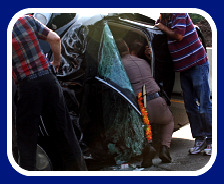
- CPR Mask - learn how to perform CPR before you need it for real.
- Elastic and crepe bandages - a few different widths.
- Gauze and non-stick dressing pads - preferably sterile.
- Gauze squares - for either applying cream, gels or antiseptic or for putting pressure on and absorbing blood from bleeding wounds. We prefer not to use cotton balls as the fibres can get left behind in the wound and may cause trouble later. But if that is all you have go ahead and use them as they are better then nothing.
- Triangular bandage - For slings, padding, strapping fractured limbs to splints if a fracture is suspected.
- Adhesive tape.
- Band aids - a variety of shapes and sizes for small cuts and scrapes.
- Instant cold packs - The kind you snap to make it cold. These are so useful with bruising, swelling and sprains. They are single use, so if you have space grab a couple for your kit.
- Two tongue depressors or ice block sticks for finger splints.
- Normal saline 10ml vials for the double use as an eye wash or wound cleansing.
- Synthetic gloves: Put in a few pairs of these.
- Moist towelettes/wipes - for those times when you need to clean dirt or mud etc off someone or something.
- Saline solution - for flushing wounds and eyes.
- Sunscreen/Insect repellent - to prevent sunburn and insect bites when that picnic or football game goes just that bit longer.
- If going on a long trip take a thermometer.
- Torch - the shake or wind up type so you do not need batteries.
- Tweezers - good quality ones. The cheap quality ones often do not do the job and are therefore frustrating.
- Curved Scissors - Scissors come in handy and have many uses. Curved medical ones are great as they don't have sharp points. In an emergency you might need to cut clothes away from an injury site and it is easy to poke through something and cause further injury when you are in a hurry or under stress.
- Mobile phone - most people have one these days but worth mentioning.
If you have children you may need to pack:
- Any prescription medication that your child might be taking including asthma inhalers, epi-pen or allergy medication.
- Children's pain reliever liquid if they have trouble swallowing tablets.
- Children's-strength liquid decongestant - again if they do not swallow tablets yet.
Storage container:
- A tackle box or art-supply box works well for storing Vehicle First Aid Kit supplies. They are lightweight, strong for when it gets knocked about, have handles for easy carrying, and generally have trays or swing out sections for storing small items to keep them in order.
- Using clip lock bags to store certain items in to categories is a great idea so things can be found in a hurry.
Other things to consider when putting together a Vehicle First Aid Kit:
If going on a long trip remember to pack in your bags any prescription medication you or other passengers are taking. Whether it be for asthma, allergies or some other aliment because a pharmacy/drug store may be quite a distance away.
When an accident or injury occurs you may not have much time to read a manual while trying to give first aid to an injured person. We recommend you do a First Aid Training Course to learn what first aid challenges you may encounter and how to treat them.
Click the below link to download the different first aid kits topics check sheet

OSHA Mandatory First aid kit check sheet
Marine First aid kit check sheet
Hiking First aid kit check sheet